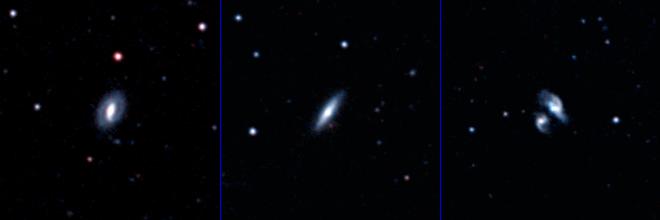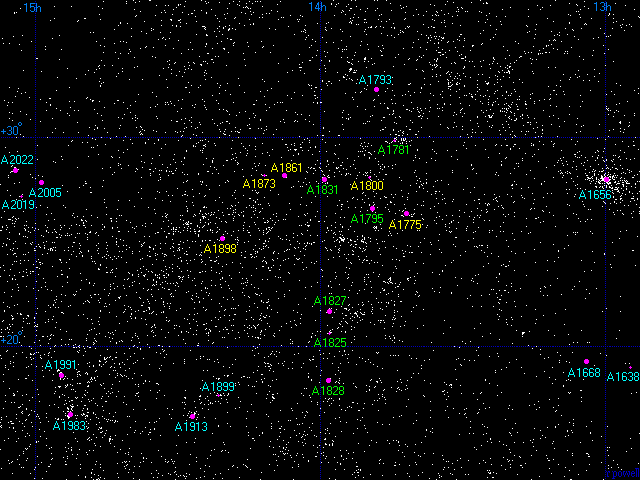
There are two superclusters in Bootes within one billion light years. The nearest one is about 830 million light years away - the second one lies directly behind it at a distance of about 1 billion light years. This map shows all of the galaxies brighter than magnitude 17 (from the HyperLeda database) in this part of the sky. The locations of the major clusters of galaxies are marked. On the right side of the map is the much closer Coma cluster (A1656), and on the left are some of the clusters in the Corona Borealis supercluster which is probably connected to the two Bootes superclusters by a wall of galaxies.

Below is a list of the major clusters of galaxies in the two Bootes Superclusters. The exact distance to one of these clusters (A1861) is currently uncertain and it could be a background cluster.
1 2 3 4 5 6 7
Abell Equatorial Redshift Distance Rich Notes
Number Coordinates z Mly
RA Dec
A1781 13 44.5 +29 51 .0606 820 0
A1795 13 49.0 +26 35 .0619 840 2
A1825 13 58.0 +20 39 .0583 790 0
A1827 13 58.2 +21 42 .0642 870 1
A1828 13 58.4 +18 23 .0611 840 1
A1831 13 59.2 +27 59 .0603 815 1
A1775 13 41.9 +26 22 .0705 950 2
A1800 13 49.7 +28 04 .0743 1000 0
A1861 14 07.5 +27 49 - - 1 uncertain distance
A1873 14 11.7 +28 09 .0764 1025 0
A1898 14 20.6 +25 09 .0762 1025 1
|
Column 1: The name/number of the cluster.
Column 2: The Right Ascension for epoch 2000.
Column 3: The Declination for epoch 2000.
Column 4: The redshift of the cluster.
Column 5: The distance in millions of light years assuming H=70km/s/Mpc.
Column 6: The 'richness' class of the cluster.
Column 7: Additional names and notes.
References:
Abell G, Corwin H, Olowin R, (1989), A catalogue of Rich Clusters of Galaxies,
Astrophys J Supp, 70, 1.
Struble M, Rood H, (1999), A compilation of redshifts and velocity dispersions for
ACO clusters, Astrophys J, 125, 35.
Below - one of the clusters of galaxies in the Bootes supercluster. This is the A1795 cluster at a distance of 840 million light years. The massive elliptical galaxy in the middle is PGC 49005.
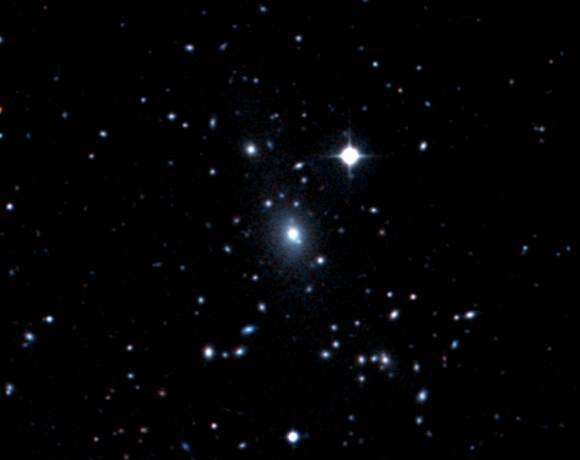
The Bootes superclusters are famous mainly because they lie next to (and slightly behind) the Bootes void. This void is one of the most famous voids in the universe mainly because it was one of the first major voids discovered. It was discovered in 1981. The centre of the void is about 700 million light years from us (redshift 0.052) and it has a diameter of about 300 million light years.
This map below is a plot of all the galaxies brighter than magnitude 17 in this part of the sky. The location of the Bootes void is marked. The void contains very few galaxies, although there are a lot of foreground galaxies between us and the void. This map shows how the void is bordered to the south and west by several major superclusters, including the Bootes superclusters to the southeast.
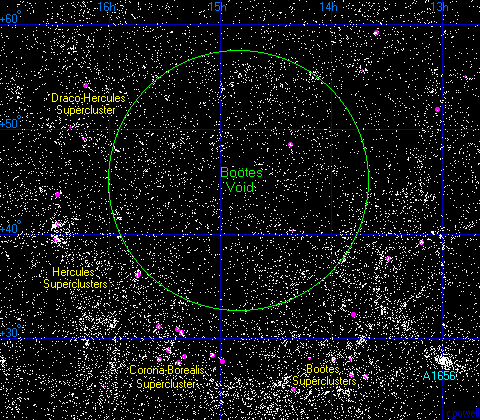
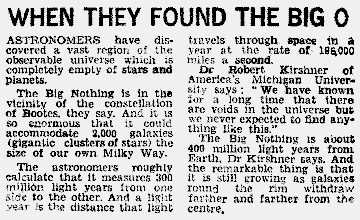
Left - A newspaper article dating from 1983 announcing the discovery of the Bootes void. This was when it was officially confirmed that it existed.
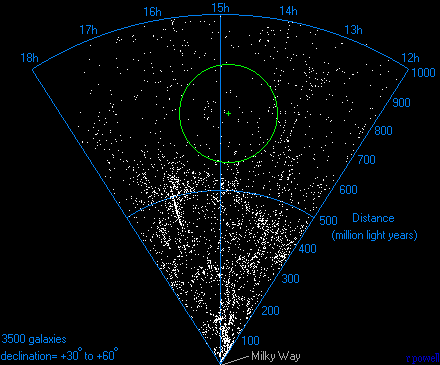
Right - a slice of the universe which shows the Bootes Void. This map is a plot of 3500 galaxies (from the HyperLeda Database) in the direction of the Bootes Void. Our galaxy is at the bottom and the top of the map is 1 billion light years away. The data is very incomplete beyond 500 million light years so the void is not very prominant, but its location is marked. Most of the galaxies located within the area of the void are galaxies which lie above and below the void.
There has been no scientific study of the superclusters in Bootes. Although these superclusters are much bigger than the Virgo supercluster, there are many closer superclusters which are considered to be more interesting.
The Bootes Void has received a lot of scientific research. The Bootes void was discovered by Robert Kirshner, Augustus Oemler Jr, Paul Schechter and Stephen Shectman in 1981. They surveyed galaxies in three small areas of the sky in this region and noticed that there was a large gap where there were no galaxies. They subsequently surveyed the entire region and in 1983 they confirmed the presence of the void. In a paper published in 1987 they produced a map of the void.
Other astronomers also began to study this void and soon discovered some galaxies within the void. J Moody, R Kirshner, G MacAlpine and S Gregory in a paper in 1987 listed eight galaxies which had been discovered in this void. Soon, it became a popular sport among some astronomers to find galaxies in the Bootes Void. M Strauss and J Huchra announced the discovery of a further three galaxies in 1988, and G Aldering, G Bothun, R Kirshner and R Marzke announced the discovery of fifteen galaxies in 1989.
By 1993, 27 galaxies were known in the Bootes Void. In this paper S Cruzen, D Weistrop and C Hoopes list these 27 galaxies. More galaxies continued to be discovered, by 1997 a total of 60 Bootes Void galaxies were known. This is still a very low number. A normal region of the universe of this size would usually contain many thousands of bright galaxies. Most of the galaxies discovered are usually located near the edges of the void.
